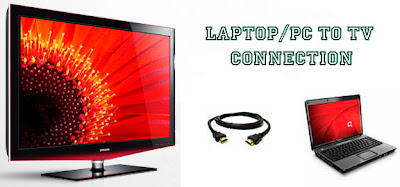
Overview
There are numerous benefits and reasons why you would want to connect your laptop/PC to your LCD TV. You can use your favorite music program to play your favorite tunes, show all of your digital photos or videos to your family, and even show a PowerPoint presentation to coworkers. Combining the laptop/PC with your LCD TV allows possibilities for the easy chair, that were once limited to the office chair.
In the following posts, I provide some information on connecting a laptop/PC to LCD TV. The information provided is not new and is available at many other sites. However, in addition to discussing some of the guidelines to performing the task of a laptop/PC to TV hookup, I finish the discussion with my experience of hooking up my laptop to a LCD TV.
There are three primary steps to performing the task at hand:
1. Identifying the available connections on both the laptop/PC and the TV.
2. Choosing a compatible connection and performing the actual physical connection.
3. Performing modifications to the Display setting on the laptop/PC and LCD TV, that will allowed what's on the computer to be viewed on the TV.
First, let's take a look at some background information in cable connections...
Cable Connection Methods to connect a laptop or PC to your LCD TV
The following is a list of the different types of cables/connections you will have to choose from with picture quality ranging from highest to lowest:
1. HDMI – "High Definition Multimedia Interface" or HDMI is the highest quality connection now. All HDTVs will have this connection though chances are your laptop or computer may not. If you do happen to have an HDMI connection on your computer then by all means, use this connection. Using HDMI will give you the best quality by far. Many of the newer computers have HDMI ports. If your PC/Laptop doesn't have one, you can get a HDMI-to-DVI cable to connect it to your LCD TV. HDMI is compatible with DVI.

2. DVI stands for "Digital Video Interface" and has pretty much been the standard for connecting computer monitors since about 2003. Your computer will most likely have this connection. HDTVs should also have this connection. If you wish to use audio with a DVI connection you must use a seperate audio cable. The digital signal will give a higher quality picture than either S-Video or VGA. Of course, your computer will need to have a DVI connection and your TV will need to be an HDTV.

3. VGA or "Video Graphics Array" connections are the most common video connections found on laptops and PC’s. HDTVs may have a VGA connection which means you simply need to connect the cable between your computer and television. However, older televisions will not have a VGA connection and will require a PC to television converter. There are USB converters that allow you to use this method. Just like DVI, VGA does not carry an audio signal. It gives much better quality than S-Video. You usually won’t find a VGA port on regular TV’s though, so this option is if you have an HDTV.

4. S-Video or "Super Video" has been around for quite some time now. Some laptops and computer graphics cards will have a S-Video connection. Most televisions will also have a S-Video connection. This isn’t the best quality connection but its also not the lowest quality. S-video has the same audio limitation as the above DVI and VGA examples. Remember, there are two types of S-Video cables: 4-pin and 7-pin. Most laptops and PC’s are equipped with a 7-pin port, so if your TV only has a 4-pin S-Video port, then this method will not work.

5. RCA - RCA connections also known as Composite connections, are the yellow, red, and white connections that most people will be familiar with. Red is right analog audio, and white is left analog audio. Yellow is composite video. This will be the lowest quality connection to use. If your computer has no RCA connections, you can use an RCA to S-Video cable.
 In part 2 of this guideline, I am going to discuss cable connection hookup based on two of the Cable connection options described above.
In part 2 of this guideline, I am going to discuss cable connection hookup based on two of the Cable connection options described above.HowTo Guideline Part 2/3>>
___




No comments:
Post a Comment